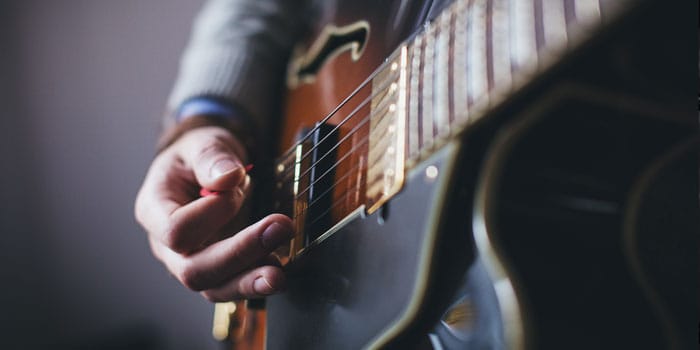HOW TO PRACTICE BEND INTONATION:
FROM BEGINNER TO ADVANCED
By: Bruno Gonçalves

Bending the strings is one of the most important techniques of electric guitar, and probably one of the most expressive too. However, bending is a double-edged sword: you can nail it and make it sound awesome, or you can make a few mistakes and it just come out pretty bad.
In my opinion, one of the major problems with bending is that some players are not aware or are not practicing their intonation right. With that in mind, I will not go into details about technique or hand positioning. The aim here is to make your bend intonation better.

This is the face you’ll make when you get your bend intonation just right!
So let’s kick your solos up a notch, fix that intonation while practicing aural skills, finding notes on the neck and developing your musical ear. Sounds good? Then let’s go. First, let me say that it doesn’t matter if you’re a total beginner or an advanced player, this article definitely has value to everyone. Keep in mind that the exercises increase in difficulty, so always practice those that aren’t too easy, but aren’t too hard too.
Important: Before doing any of these exercises, make sure your guitar is in tune. Only move to the next exercise when you’re already comfortable doing the current one.
Exercise 1
In order to begin training our ears for bending intonation, first we need to have something to compare it to. Just playing and ‘trying to figure it out’ is not what you should be doing to get results fast.
Start by recording the sound of the fret that you are bending to without doing any kind of vibrato or changing the pressure that you normally apply to play. Pick the note again when it starts to fade away, recording like 20 seconds of that note only. So if you’re bending a whole tone in the 13th fret of the B string, record the sound of the 15th fret.
- The next step is to play that sound on your smartphone or computer, and try to hit that note while bending. Note that the closest you are, the more harsh it sounds (the notes collide and sound like they are being cut). You should focus on developing your ears and also paying attention to how much you’re bending the string up.
- If you were practicing whole tone bends and you are hitting them pretty easily, now change it up and use the same note you recorded to practice half-step bends. All you need to do is start the bend a fret higher and target the same note.
- Do this exercise in other strings and other frets, initially only between frets 7 and 15.
Exercise 2
For the second exercise, you will not use recorded audios of the target notes. Now it is time to develop your ears without it. Choose a fret and a bend size, play the target note just like you did before (without changing the pressure or doing vibrato) and pay full attention. Now, bend the strings while really trying to reach it (retry multiple times if needed) and after a few secs, stop bending and go back to the target note to see if you got it right or not.
As with the previous exercise, do it in various frets and strings around the neck. When you feel comfortable doing whole step bends, try bending only half-step.
Exercise 3
Since we’re musicians, our aim in everything we practice is to play music with it. Now it’s time to put things into a real musical context. In order to hone your listening skills, you’ll compare your bend intonation to a chord, not just a single note.
Start by finding a vamp or one chord backing tracks (you can find them on YouTube or other places). You will bend to the root note of the chord: if you’re in Am, all the bends will target the A note (it doesn’t really matter if they are half-step on whole step), so start by finding at least 3 root notes of that chord before proceeding with the exercise.
It probably won’t be as easy as when thinking on the target note exclusively, without chords or drums in the back, but it will come naturally. This is a very important step to developing your ear, as when you improvise or play songs, everything you do will relate to the background harmony and instruments.
When it starts to become easier, try bending to the other notes on the triad (the 3rd and the 5th) and figuring out if are getting the intonation right. Keep in mind that you can play the target note over the chord a few times, in case you’re really having a tough time trying to get it right.
Exercise 4
The last exercise will be very similar to the last one, but this time you’ll choose a backing track that has 4 chords (not more, otherwise it’ll become confusing).
This time, you’ll start by bending notes that are inside the scale to the root notes of every chord. That means some bends will be half-step, and others will be whole-step. Also, your ear has to pay attention to the chord changes to get the bends right.
For example, let’s say the backing track uses the following chords:
Em C G D
That means the backing is in the key of E minor, and you have to:
- E minor chord: bend the D note a whole step to E.
- C chord: bend the B note half a step to C.
- G chord: bend the F# note half a step to G
- D chord: bend the C note a whole step to D.
Bonus:
For whole tone bends, it is possible to practice them in another way, although it is technically harder. When you do a whole step bend, you’re targeting the note that is 3 frets behind on the string directly below it. So, if you’re bending the 7th fret on the D string, (whole tone), you’re targeting the 9th fret of that string, which is exactly the same note as the 4th fret of the B string (try it out!). Note that the only exception is when the bend occurs on the G string, in that case the target note is only 2 frets behind it on the B string.
Both examples are on the tab below.

With that in mind, you can either bend while holding that other note on the string below it or play it after the bend to have a real time comparison to know if you’re getting it right.
Finishing up
Repeat every exercise multiple times, always paying attention to the intonation (even if you can’t really tell at first if it’s in tune or not). I do not recommend practicing bend intonation too much time in the same practice session because of the concentration needed. Instead, spread the time over various practice sessions, so you practice it often and get better results. It may seem hard at first, but you have to trust me that it will get easier and you WILL be able to do it.
It is a good idea to practice these exercises with distortion (preferably hi-gain), so you have more sustain and more time to tell if you intonated the bend correctly. Also, you can use the time to clean up some of your bends, and both of these wouldn’t be possible while playing without distortion.
About the author: Bruno Gonçalves is an electric guitar teacher, professional musician and digital effects enthusiast from Ribeirão Preto, Brazil. To find out more about his work or read more articles, you can visit his website.


Dylan is an incredible teacher and a reliable instructor. I've been taking lessons with Dylan for over 6 years and he has helped me improve so much over that time. He has helped me with song writing, guitar techniques, and music theory over the course of our many lessons. I highly recommend Dylan as a teacher!
"Dylan is a fantastic teacher. I've been playing on and off for 10 years and could never figure out how to solo. After only 3 months of lessons, I am soloing up and down the entire neck (and it actually sounds good!). I would highly recommend lessons with Dylan."
"I've been taking lessons from Dylan for about eight or so months now. And without a doubt, they have been an awesome eight months. its structured, but doesn't feel like a normal classroom setting where you sit and listen. He walks you through everything, and makes sure not to overwhelm you. I've learned a lot and have also started to learn bass from him, which after only two weeks is proving to be just an enjoyable. Definitely check him out if you're ever interested Iearning how to play the guitar!"
"My son took lessons from Dylan and learned a tremendous lot! His lessons are challenging but fun! Very highly recommended."
"Dylan is an excellent teacher. He has customized each lesson to suit my level. This is my first time taking lessons and he has been very patient. I have progressed very quickly and had a lot of fun with Dylan. He has a great personality for teaching and is very skilled."
Dylan is fun to talk to, he can play guitar really well, he has great songs. He is very helpful and shows me to play chords in songs. Learning is fun, he has games for fun and to learn. At the beginning I had no idea what I was doing, and I am great now. I still have stuff to learn.
By Ryan - 11
We are very happy with Summit School Of Guitar.
Dylan offers a happy & nurturing place for kids to learn. He is very friendly and motivating, he can relate to kids and they love him. ADHD is not a problem. ❤️
Dylan is an excellent teacher. I've been with him for just a few months now and I've come so far. His lessons are very goals oriented which is nice for me because he asked me what my goals with guitar are and planned my lessons around helping me to best reach my goals in the most efficient way possible. He is a fun and energetic teacher and never acts like he is just here to get a paycheck like so many other guitar teachers. You can tell he cares about each of his students and their progress as guitar players. Taking lessons from Dylan has turned Mondays into my favorite day of the week!
Like many, I have been playing for many years (since 1975) and never took a professional lesson. After considering all of my options, I contacted Dylan Andrews because of his high ratings and good reviews. Was very impressed with Dylan at our initial consultation because he was interested in “My Goals”. Have been going weekly now for 10 months and am astonished at how far I have come. Now, I am doing things on the guitar that I never thought possible. Be prepared to SHOCK you family and friends (as they stare at you with their mouth hanging open) as you play at a family gathering, or on the front porch. Sure wish I did this 40 years ago. Soon, I will be recording my own music for my cooking videos.
Dylan Andrews is a highly reliable teacher and did a great job helping my son set clear goals and work towards them. I knew Dylan was a good player but was impressed with how well he teaches. My son picked up chord changes and playing melody faster than I expected.
Home | Who’s The Fastest Guitar Player In The World (And Why You Shouldn't Care) | Improving The Sound Of Your Strum So That You Can Sound More Professional | 3 Easy Ways To Make Practice Fun Every Time You Pick Up Your Guitar | How To Encourage Your Child To Practice Their Guitar| 5 Ways To Get More From Your Guitar Lessons | Battling Discouragement As You're Learning To Play The Guitar| Fun Way To Build Picking Hand Independence for Beginner Guitarists | Becoming A Self-Effulgent Musicians | 9 iPad Apps That Will Greatly Enhance Your Playing | Learn To Master Scales | Choosing The Best Guitar Pick | How To Practice Bend Intonation | About | Guitar Lessons For Kids | How To Track Your Progress With A Metronome | How To Buy Your Kids First Guitar | What To Expect On Your Guitar Journey | 5 Things You Can Do To Make Your Guitar Practicing More Effective And Reach Your Goals Sooner | How Bruce Lee Will Make You A Better Guitar Player | What To Expect On Your Guitar Journey | Contact







